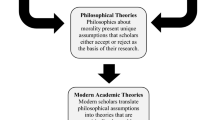Abstract
The "ethical environment of business" provides a constructive frame of reference for business ethics instruction. As illustrated by a suggested role play about foreign sweatshops, it provides a realistic, problem-solving context for the study of moral and ethical ideas. Once ethical behavior is viewed through this paradigm, students can better see how business policies are shaped by ethics and prepare themselves to react to their own ethical environment.
Similar content being viewed by others
References
ABC News: 1995, ‘Liz Claiborne and Overseas Labor’, 20/20 broadcast, May 1995.
Anonymous: 1995, ‘Doing Worse by Doing Good?’, Business Week, June 12, 1995, p. 50.
Beach, J.: 1987, ‘Business Law — Education or Training? A Justification for the Inclusion of Ethics in Business Law’, Journal of Legal Studies Education 6, 141–150.
Brown, K. M.: 1994, ‘Using Role Play to Integrate Ethics into the Business Curriculum: A Financial Management Example’, Journal of Business Ethics 13, 105–110.
Castro, B.: 1989, ‘Business Ethics and Business Education: A Report from a Regional State University’, Journal of Business Ethics 9, 479–486.
Cava, A.: 1990, ‘Teaching Ethics: A Moral Model’, Business and Economic Review 36, 10–13.
Coats, S.: 1995, ‘Organizing and Repression’, Multinational Monitor 16, “http://www.essential.org/images/monitor.gif”, June 1995.
Coats, S.: 1991, ‘Made in Guatemala — Union Busting in the Maquiladoras’, Multinational Monitor 12, “http://www.essential.org/images/monitor.gif”, Nov. 1991.
Collins, G.: 1996, ‘S.E.C. Allows Priests' Bid for Vote on Nabisco Spinoff’, New York Times, Jan. 3, 1996, p. D3.
Collins, J. W.: 1992, ‘Experienced-based Ethics Study: The Implications for Business Law Teachers’, Journal of Legal Studies Education 10, 107–120.
Cowton, C. J. and T. W. Dunfee: 1995, ‘Inter-nationalizing the Business Ethics Curriculum: A Survey’, Journal of Business Ethics 14, 31.
Delaney, J. R. and D. Sockwell: 1992, ‘Do Company Ethics Training Programs Make a Difference?: An Empirical Analysis’, Journal of Business Ethics 11, 719.
Donaldson, T.: 1989, The Ethics of International Business (Oxford University Press, New York), pp. 97–104.
Earle, B.: 1994, ‘Integrating Ethics into an International Business Law Course’, Journal of Legal Studies in Education 12, 43–57.
Entime, J.: 1994, ‘Shattered Image’, Business Ethics 8, 23–28.
Ethics Resource Center: 1994, Ethics in American Business: Policies, Programs and Perceptions (Ethics Resource Center, Inc, Washington D.C.), pp. 29–42.
Frederick, R. E. and M. W. Hoffman: 1989, ‘Business Ethics in the Curriculum: Stranger in a Strang Land’, International Journal of Value Based Management 2, 19–31.
Getz, K. A.: 1991 ‘International Codes of Conduct: An Analysis of Ethical Reasoning’, Journal of Business Ethics 9, 567–577.
Globalvision [I]: 1996, ‘Rights & Wrongs: Labor Abuses’, aired over Public Broadcasting Service, April 1996 (transcript on file with author).
Globalvision [II]: 1996, ‘Rights & Wrongs: Child Labor’, aired over Public Broadcasting Service, July 1996 (transcript on file with author).
Greenhouse, S.: ‘A Crusader Makes Celebrities Tremble’, New York Times, June 18, 1996, p. B4.
Harris, J. R.: 1991. ‘Ethical Values and Decision Processes of Business and Non-business Students: A Four-Group Study’, Journal of Legal Studies Education 9, 215–219.
Hosmer, L. T. and S. E. Masten: 1995, ‘Ethics vs. Economics: The Issue of Free Trade with Mexico’, Journal of Business Ethics 14, 287–295.
International Labor Organization (ILO): Homepage’ webinfo@hq.ilo.ch.
Lane, M. S. and D. L. Schaupp: 1992, ‘Teaching Business Ethics: Bringing Reality to the Classroom’, Journal of Business Ethics 11, 225.
Martinez-Mont, L.: ‘Sweatshops are Better than No Shops’, Wall Street Journal, June 25, 1996, at p. A16.
McDonald, G. M. and G. D. Donleavy: 1995, ‘Objections to the Teaching of Business Ethics’, Journal of Business Ethics 14, 839–853.
Miller, R. A.: 1994, ‘A Proposed Paradigm for a Reflective Exercise on the Values Underlying Codes of Conduct’, Journal of Legal Studies Education 12, 301–303.
Morris, R.: 1980, ‘Coca-Cola and Human Rights in Guatemala’, in ICCR Brief (Interfaith Center on Corporate Responsibility, Washington D.C).
Nichols, M.: 1993, ‘Third-word Families at Work: Child Labor or Child Care?’, Harvard Business Review 72, 14–23.
Ortega, B.: 1995, ‘Conduct Codes Garner Goodwill for Retailers but Violations Go On’, Wall Street Journal, July 3, 1995, p. A1.
Pollock, E. J.: 1996, ‘CEO Takes on a Nun in a Crusade Against “Political Correctness”’, Wall Street Journal, July 15, 1996, p. A1.
Public Broadcasting Service: 1996, ‘We Do the Work: Child Labor’, broadcast, spring 1996.
Rawis, J. S.: 1971, A Theory of Justice (Harvard University Press, Cambridge).
Reed, O. L.: 1990, ‘King Contracts Wears No Clothes’, Journal of Legal Studies Education 9, 31–36.
Rohter, L.: 1996, ‘Hondurans in “Sweatshops” See Opportunity’, New York Times, July, 18, 1996, p. A1.
Samuels, L. B.: 1994, Book Review — ‘“The Ethics of International Business” by Thomas Donaldson’, Journal of Legal Studies Education 12, 115–118.
Schoenfeldt, L. F., D. M. McDonald and S. A. Youngblood: 1991, ‘The Teaching of Business Ethics: A Survey of AACSB Member Schools’, Journal of Business Ethics 10, 237.
Solberg, J., K. C. Strong and C. McGuire, Jr.: 1995, ‘Living (Not Learning) Ethics’, Journal of Business Ethics 14, 71–81.
Stark, A.: 1993, ‘What's Wrong with Business Ethics?’ Harvard Business Review 72, 38.
Weber, L. J., J. Hammang-Buhl and L. Levitt: 1991, ‘Who Sets the Agenda? Integrating Ethics into Functional Business Courses’, Journal of Legal Studies in Education 9, 205–213.
Zachary, P. G.: 1995, ‘Starbucks Asks Foreign Suppliers to Improve Working Conditions’, Wall Street Journal, Oct. 23, 1995, p. B6.
Author information
Authors and Affiliations
Rights and permissions
About this article
Cite this article
Raisner, J.A. Using the "Ethical Environment" Paradigm to Teach Business Ethics: The Case of the Maquiladoras. Journal of Business Ethics 16, 1331–1346 (1997). https://doi.org/10.1023/A:1005710519699
Issue Date:
DOI: https://doi.org/10.1023/A:1005710519699




